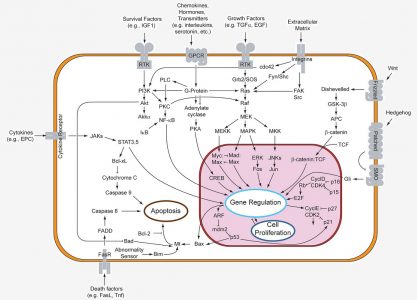Types of Cell Signaling
There are 5 main types of cell signaling which are mainly classified by how far the signals must travel, and the ultimate proximity of the cells sending and receiving the cells.
Intracrine signals stay within a single cell, but are used by the cell to coordinate and control the many biochemical reactions taking place at any given moment.
Autocrine signals are released by a cell, but are still intended to take action on the cell itself. These signals can also travel short distances outside of the target cell and affect near-by cells. Immune cells commonly secrete autocrine signals.
Juxtacrine signals are sent from one cell to a neighboring cell that it is physically touching. Typically, these signals are transmitted through some of the same proteins and molecules which hold the cells together, which insures that a bonded tissue will produce a cohesive reaction.
Paracrine signals are sent from one cell to another cell in its immediate proximity. A great example of paracrine signaling is found in the nerve cells. When a nervous signal is to be passed from one cell to another, the sending cell released neurotransmitter molecules, which act as a signal for the second cell to initiate and transmit a signal. These signals only travel short distances.
Endocrine signals are sent very long distances, often by the tissues in your body that secrete hormones. Hormones are able to circulate through the blood, affecting many different cell types throughout the body to create a unified response.
The following image shows a wide variety of cell signaling pathways within a single cell, and the many different biochemical reactions they stimulate.
Stages of Cell Signaling
Cell signaling can vary, based on the types and kinds of receptors and signaling molecules being used. However, a typical pattern emerges in all forms of cell signaling.
First, the cell must be exposed to an environment or condition which causes it to send a signal. This may be things like temperature, other signal molecules present, or even sugar levels within the blood. Then, the cell must produce the signal. Some signal molecules are actively produced when the cell is stimulated, while others (like neurotransmitters) are stored and ready for release.
When the cell receives this signal, a cascade of events will release the signal molecule. Some signal molecules stay within a cell, while others travel outside the cell to find target proteins on other cells. These receptors can bind to the signal molecule, and in turn they transduce the signal. This process involves the protein binding to the signal molecule, changing shape, and consequently stimulating a process within the cell. In nerve cells, for instance, when neurotransmitters bind to receptors on the surface of a nerve, these proteins cause an influx of ions. In turn this creates an electrical impulse which will travel the length of the cell and is the basis for how nerve cells transmit signals.
The final step in any cell signaling is the whole system resetting into a “normal” position. The signal molecule will unbind from the receptor protein, stop the transduction of the signal into the cell, and allow the cellular machinery to prepare for another signal.

